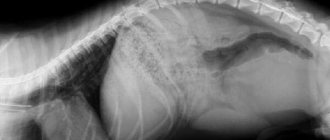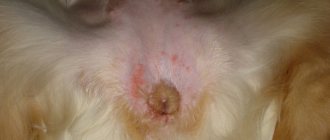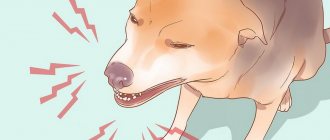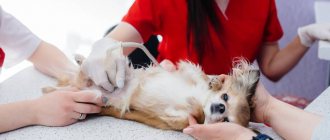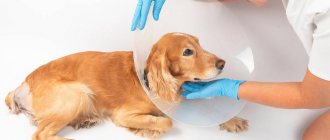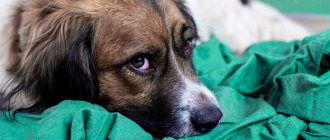Leptospirosis is an anthropozoonotic multisystem disease. It affects almost the entire body: liver and kidneys, lungs, spleen, anterior chamber of the eye, retina, cardiac and skeletal muscles, meninges, genitals and pancreas. In addition, it inhibits blood clotting. The development of the disease in dogs does not depend on age, gender or breed. But young individuals are most susceptible to the disease.
What kind of disease is leptospirosis in dogs?
Alternative names are Weil's disease and infectious jaundice. Its causative agent is the spiral-shaped bacterium Leptospira. It is resistant to most adverse factors and is able to remain viable even at -70 °C.
In frosty times, leptospira are less active, so outbreaks of diseases decrease with the arrival of winter. The most favorable environmental conditions for this microorganism are high humidity and heat. Because of this feature, it is often found in stagnant bodies of water and wet soil.
After entering the body of an infected person, leptospira quickly spreads through his blood vessels, liver, kidneys and other important systems. Their waste products lead to severe intoxication, thicken the blood, form blood clots and disrupt the functioning of internal organs.
Prevention
Preventive measures will help in the fight not only against Leptospira, but also against most pathogens of infectious diseases:
- Timely vaccination and immunization of dogs.
- Rodent control.
- Sanitation of places where dogs are kept, especially in shelters for homeless cats and dogs.
Dogs and puppies may shed pathogenic bacteria for many months after recovery. Owners of dogs that have suffered an infestation should take this fact into account and isolate their pupils until tests show the absence of Leptospira.
Methods of infection
Animals with low immunity are vulnerable to the disease: puppies under 6 months of age, elderly dogs and pets with chronic pathologies. You can become infected with bacteria during:
- Swimming in stagnant ponds
. Puddles and creeks are the usual habitat of Leptospira. In such an environment, microorganisms live up to 200 days. They are not afraid of the absence of a host, so the only real threat is frost, which prevents active reproduction.
- Crowded content
. The small area of premises in nurseries increases the risk of epidemics. If at least one of the animals is infected, all the inhabitants will be at risk.
- Pregnancy and lactation
. In these cases, microorganisms pose a danger not only to the infected mother, but also to her offspring.
- Drinking contaminated water or food
. A common cause of infection is meat served without heat treatment.
- Contact with vector animals
. The disease is transmitted by other sick dogs, small rodents and blood-sucking insects. Also dangerous are arctic foxes, foxes, martens or other predators that have eaten an infected mouse or rat.
Regardless of the method of infection, the bacterium penetrates either through damaged skin and mucous membranes, or through the mouth. The carrier becomes dangerous to others during the incubation period.
What to do at home
All home remedies are powerless against leptospirosis. Only treatment prescribed by a specialist can save a dog. The owner is required to create the most comfortable conditions for the four-legged pet, peace and good nutrition.
Since the animal is a source of infection, it should be kept in a separate room, and it should be cared for using precautions (use a change of clothes and gloves). The places where the animal defecated are washed using bleach and disinfectants with the addition of iodine.
Weakened animals, as a rule, refuse to eat, but there is no need to force feed. During treatment, the dog's diet consists of dietary dishes low in protein.
When the pet begins to recover, it should also consume exclusively gentle foods that eliminate the burden on the liver and other organs damaged during the illness. The dog will follow this diet for the rest of its life.
It is preferable to use special medicated food, which can be purchased at a veterinary clinic. If the dog is fed natural food, then the diet should include boiled chicken or turkey, oatmeal and rice porridge cooked in water, vegetables, fruits (if there are no exacerbations of gastroenteritis).
The dog should receive the required amount of water, to which a decoction of the choleretic herb should be added.
Symptoms of the disease
A sick pet's activity decreases and its health gradually worsens. The infection can be recognized by the following symptoms:
- increased heart rate, as well as a sharp rise in temperature to 42 ° C;
- the appearance of a fetid odor of ammonia from the mouth, yellowing of the mucous membranes, conjunctiva and whites of the eyes;
- refusal of water, which reduces the frequency of urination;
- the formation of small suppurating ulcers in the mouth that resemble scratches;
- heavy and frequent breathing with gurgling and wheezing;
- bloody vomiting and diarrhea, alternating with constipation;
- unpleasant-smelling coating on the skin and coat;
- blood in the urine, changing its color to brown;
- severe painful spasms during palpation and the occurrence of convulsions;
- tissue necrosis on the nose.
Gradual exhaustion of the body over time leads to a drop in temperature. A week later it drops below 37.5 °C, going beyond the lower limit of normal. By this time, the chances of saving the dog are already minimal.
The most dangerous form of pathology is asymptomatic. Due to late diagnosis, veterinarians rarely give a favorable prognosis.
The opposite situation is typical for owners of numerous folds on the skin: basset hounds, sharpeis, bloodhounds, bulldogs, pugs, mastiffs. Infection of these breeds is accompanied by the most striking symptoms, so owners notice pathological changes before irreversible complications appear.
Is leptospirosis dangerous for humans?
Human infection occurs through caring for animals, drinking raw milk, contact with dog excrement, and swimming in lakes and ponds. The pathogen enters through unwashed hands, drinking raw milk from a sick animal, swallowing water from a reservoir, or penetration of the pathogen through scratches, the mucous membrane of the nose or eyes.
Direct transmission of the pathogen from person to person is unknown.
The insidiousness of contagion lies in the large number of serotypes. If a person has had one type of leptospirosis, he is defenseless against others. If left untreated, death can occur.
Forms of the disease
Leptospira disrupts the permeability of blood vessels, thinning and injuring them. Due to numerous injuries, hemorrhagic syndrome occurs - a pathological condition accompanied by extensive bleeding. Depending on its severity, the disease is divided into 2 forms: hemorrhagic and icteric.
Hemorrhagic
Hemorrhagic leptospirosis in dogs is characterized by rapid development and frequent death. The main impact falls on the patient's liver. Internal disorders are accompanied by severe pain, cramps, pinpoint hemorrhages and the appearance of scarlet blood in the stool. Due to the gradual failure of the animal's organs, urination is reduced and then completely stopped.
Jaundice
The probability of death with the icteric form is lower and is 55% versus 80% with the hemorrhagic form. Its main symptom is yellowing of the skin and mucous membranes, which is clearly visible in the photo. Yellowness is easy to detect in hairless areas, but if you part the fur of a sick pet, changes in skin color can be seen there too.
Despite the more optimistic prognosis, this form is characterized by vivid symptoms. It can be easily detected by the intense suffering of the animal.
According to the degree of manifestation
Depending on the degree of manifestation of symptoms and the speed of development of the disease, 4 more forms are distinguished. These include:
- acute
, developing within 2 days and accompanied by rapid failure of internal organs;
- subacute
, characterized by less pronounced symptoms and a more favorable prognosis (lasts up to 20 days);
- chronic
, which appears as a result of complications of the first 2 forms and is accompanied by a series of remissions and relapses;
- latent
, excluding the presence of symptoms.
Chronic leptospirosis in dogs is rarely completely curable. Most often, such patients are prescribed lifelong maintenance therapy.
It is also important to note the peculiarity of the latent form. Despite the absence of symptoms, an infected dog continues to be a carrier and can infect other animals.
Main symptoms
Signs of leptospirosis will vary depending on the form of the disease, of which there are four.
The apathetic (latent) variety is considered the most harmless. Characteristic signs include a slight increase in body temperature (maximum 1 degree), a depressed state of the animal, pallor or yellowness of the mucous membranes. Symptoms disappear on the second day after infection, and the dog recovers.
The chronic form is the rarest. The animal is losing a lot of weight, and the lymph nodes in the groin and under the jaw are enlarged. The temperature rises from time to time, the urine becomes brown or dark yellow, and the fur on the sacrum and other areas thins out. The dog hides from people, looking for the darkest places. Pregnant bitches give birth to dead offspring.
The fulminant (superacute) form lasts up to two days and has a pronounced clinical picture. Body temperature rises sharply (up to 41.5 degrees) and persists for several hours, then drops (up to 38 degrees). The dog's behavior changes, as a rule, it becomes violent and aggressive.
Yellowing of the mucous membranes and rapid breathing are observed. This is the most dangerous form, since if the animal does not receive medical attention, it will die.
The acute form is observed in young dogs. The temperature rises (up to 41.5 degrees), the mucous membranes and sclera become yellow. Urine is released in small portions and has a brown tint. Sometimes there is diarrhea, and blood can be seen in the stool. The dog, suffering from severe pain in the lower back, rushes about, whines, and worries.
Necrosis of the epidermis develops, ulcers, erosions, and bruises form on the skin. The fur becomes dull and dandruff appears.
The subacute form lasts 2-3 weeks and is characterized by the following symptoms: general exhaustion, weakness, trembling of the limbs, purulent discharge in the corners of the eyes, fever up to 39.5 degrees. Signs inherent in the acute form are also observed, but they are not so pronounced. This variety is also dangerous and leads to the death of the dog in half of the cases.
Development of the disease by stages
After infection with bacteria, the disease goes through 2 stages: bacteremic and toxic. The first stage is the incubation period, which involves the reproduction of Leptospira, but excludes the onset of inflammation.
Depending on the strength of the immune system, incubation takes from 2 to 30 days. During this time, the invaders are carried through the bloodstream to the main systems and organs. Here they settle and begin to replenish their ranks.
After the incubation period, leptospires return to the bloodstream, but this time releasing toxins. Their waste products, which poison the patient’s body, lead to the appearance of the first symptoms.
An infected person becomes a carrier of pathogenic microorganisms already 5-7 days after infection, regardless of the presence of symptoms. The bacteria come out along with its biological fluids and retain their virulence (the ability to infect) even after the animal has recovered. A recovered dog acquires lifelong immunity, but continues to be a carrier for up to 4 years.
Question answer
In this section I will answer questions on the topic that dog breeders ask most often.
Is it possible to vaccinate against leptospirosis?
Getting vaccinated against leptospirosis is not only possible, but also necessary. If you live in an area that is free from leptospirosis, do not flatter yourself. Tomorrow, prosperity may disappear, because there are many carriers of infection - rodents, stray dogs and cats.
Complex and single vaccines against leptospirosis have been developed for dogs.
A vaccination schedule with Nobivak vaccines has been developed. The figure shows that puppies are immunized against distemper, enteritis, hepatitis (DHP) and leptospirosis simultaneously at 8-9 weeks and consolidated at 84 days. The biological product DHPPi (Pi-parainfluenza) and RL (rabies plus leptospirosis) are used. Vaccinate adult dogs annually, once, according to the same schedule as twelve-week-old puppies. If recommended by your veterinarian, additionally immunize your pet against leptospirosis with the monovaccine.
I anticipate the question: “Can leptospirosis occur in a vaccinated dog and if so, what are the symptoms? My answer is: there are no vaccines that provide 100% protection.
Objective reasons:
- vaccination during the incubation period;
- individual characteristics of the dog;
- crowded conditions in the nursery;
- the dog became infected with a leptospira serotype, the antigens of which are not in the biological product.
Human factor:
- violations of storage and (or) transportation rules;
- non-compliance with quarantine measures - you decided to walk the dog before the bactericidal antibody titer had formed;
- vaccination without prior deworming;
- improper maintenance and feeding.
The symptoms of the disease in the vaccinated dog are erased.
Can it be cured without consequences?
A recovered dog gains lifelong immunity. However, no one can guarantee that the dog will not subsequently develop some disease. It is impossible to determine what it is: the consequences of leptospirosis, an independent pathology or a symptom of another disease.
Therefore, be prepared for the fact that your pet will develop health problems over time. When taking a medical history, notify your veterinarian that your dog has had leptospirosis.
What tests are taken to diagnose leptospirosis?
Analysis for leptospirosis consists of biochemical and serological tests of blood and urine. The veterinarian will take a blood sample and you will need to collect urine. It should be warm and fresh, picked less than two hours ago. If leptospirosis is suspected, the sample is sent to a state laboratory.
How can you help at home?
Place the dog in a warm place on soft bedding and call a veterinarian. Trying to cure your pet on your own will waste time.
Establishing diagnosis
The further fate of the sick pet depends not only on the form of the disease, but also on a timely diagnosis. If a four-legged patient gets to the veterinary clinic before the onset of the toxic stage, then the likelihood of complications developing is minimal.
Doctors use urine and blood tests to identify bacteria. The diagnosis is confirmed by detecting antibodies produced by the body to fight off invaders, or the leptospires themselves. After this, an ultrasound and x-ray of the abdominal cavity are performed to become familiar with the changes in the internal organs. The study of the organs themselves is permissible only in the event of the death of the animal.
Diagnostics in a hospital
To make an accurate diagnosis, the veterinarian, in addition to collecting an anamnesis, will need to carry out a number of diagnostic measures. Blood and urine are required to be examined, and in some cases, discharge from the genitals.
Urine is studied under a microscope (microscopy method), and cultures are carried out on special laboratory media. This is necessary in order to identify living pathogens. Important: the analysis will only be informative if the dog has not yet been given antibiotics. Discharge from the genital organs is also examined under a microscope.
A blood test is needed to detect antibodies to Leptospira. The study is carried out twice with an interval of 7 days. If a dog is sick with leptospirosis, the amount of antibodies in the blood increases several tens of times.
A necropsy is performed on the deceased animal to examine fluid from the peritoneum, chest, as well as the liver and kidneys.
Stages of treatment
Treatment of pathology is based on an integrated approach. The main task is to destroy the pathogen. Equally important is the elimination of the consequences of intoxication - the functioning of damaged organs is normalized with the help of drug therapy and a therapeutic diet.
Elimination of the pathogen
Pets brought to the veterinary clinic no later than 6 days after infection are injected with hyperimmune serum. It contains protective antibodies that help develop passive immunity within 3 hours after the injection. It lasts up to 2 weeks. If the animal’s condition is critical, then the serum is administered twice, reducing the initial dose by 2 times.
In case of later treatment, antibiotic therapy is carried out. Due to the increased sensitivity of bacteria, the duration of this stage is short. The majority of treatment is supportive care.
Maintenance therapy
Taking antibiotics (Kefzol, Tetracycline, Levomycetin, Streptomycin) negatively affects an already weakened immune system. To stimulate protective cells, patients are prescribed immunomodulators (Likopid, Hemobalance), mineral and vitamin complexes.
In case of severe exhaustion, frequent vomiting and diarrhea, the animal is placed in a hospital. To normalize his condition, he is given drips with rehydration and physiological solutions. After vomiting stops, sorbents are prescribed to normalize stool. Drugs are prescribed individually to restore the functioning of the liver, kidneys and heart.
Diet
To reduce the load on the affected organs, the patient's usual portions are reduced, increasing the frequency of feedings. Products with low protein and fat content are welcome.
With natural nutrition, all food undergoes mandatory heat treatment and is served boiled. All meals should be warm and fresh, so it is easier to follow a diet with the help of medicated food.
Your attending physician will help you decide on a specific brand of veterinary food. Veterinary lines contain all the necessary nutrients and eliminate the need for additional vitamins. Dry granules can be combined with wet canned food. The packages must be marked k/d (medicinal).
Treatment at home is permissible only after the body temperature has normalized and the likelihood of death has been eliminated. To check the effectiveness of therapy, tests are taken again after the time indicated by the doctor.
How and with what to treat
Treatment of leptospirosis in dogs must be comprehensive.
Main stages of treatment:
- I – destruction of the pathogen;
- II – restoration and maintenance of the cardiovascular system;
- III – elimination of intoxication, stopping attacks of vomiting and diarrhea;
- IV – restoration and maintenance of the kidneys and hepatic system, normalization of the gastrointestinal tract.
The fight against leptospira always comes first. All other stages can change their sequence at the discretion of the attending physician, depending on the condition of a particular four-legged patient.
Self-medication is prohibited! All procedures are carried out in a hospital setting and/or under the strict supervision of a veterinarian, observing personal safety measures against potential infection.
| for a dog weighing up to 10 kg – 3 mg/animal, over 10 kg – 0.2-0.3 mg/kg body weight in a course of 7 injections every other day. If there is severe kidney damage, the dosage of polyoxidonium should not exceed 0.1 mg/kg, and injections should be given no more than twice a week. | once a day subcutaneously at a dose of 0.5 ml per kg of body weight. Duration of administration – up to 3 days. It is important to catch up in the first 3-6 days after the symptoms of the disease were noticed. |
Antibiotic therapy is carried out by intramuscular injections of penicillin drugs. Do not use sulfonamides! | |
| Bicillin-1,3, benzylpenicillin | 10-20 thousand units/kg body weight once every 3 days (only 2 injections per week). Course – up to 6 injections. |
| Streptomycin | 10-15 units/kg twice a day for a course of 5 days. |
Immunomodulators | |
| Lycopid | dogs up to 3 kg - 0.5 mg (1/2 tablet), over 3 kg - 1 mg (1 tablet), over 6 kg - 2 mg (2 tablets) once a day for 10 days. |
| Polyoxidonium-vet | |
Rehydration (restoration of water-salt balance) | |
| Ringer-Locke solution | up to 20 ml/kg body weight intravenously (slow stream or drip). |
| Trisol | at the rate of 8-10% of the total weight of the animal. |
To maintain nutrition of the heart muscle | |
| Thiotriazoline tablets | individuals up to 10 kg – ½ table. 2 times/day, up to 20 kg – 1 tablet. 2 times/day, more than 20 kg – 1 tablet. 3 times/day. |
| Thiotriazoline in solution | individuals up to 5 kg - twice a day, 0.5 ml into a muscle or once 1 ml intravenously, up to 10 kg - twice a day, 1 ml intramuscularly or once 2 ml into a vein, up to 20 kg - 1.5 ml into a muscle twice/day or 3 ml once intravenously. |
| Riboxin | 5-10 mg/kg body weight every 12 hours for 2 weeks. |
To maintain heart function | |
| Cordiamine | up to 3 drops per tongue or 0.1 ml/kg (strictly when weakness is detected). |
To restore damaged blood vessels | |
| Askorutin (50 mg rutin + 50 mg ascorbic acid) | daily dose: ½ tablet/10 kg weight orally. Divided into 2 doses. The course is at least a month. |
Detoxification of the body | |
| 25% magnesium sulfate + 40% glucose | intravenously or drip from 5 to 25 ml, depending on the size of the dog. |
| Hemodez | up to 10 ml/kg once or twice a day intravenously until signs of intoxication subside. Prescribe with caution in case of significant impairment of kidney function. |
| Sirepar | by slow intramuscular or intravenous administration of 3-4 ml once a day until signs of intoxication disappear. |
Antidiarrheal care | |
| Enterosgel | for small individuals 1 tsp, and for large individuals up to 2 tbsp. Dissolve the gel in 200 ml of water and drink it or pour it into the mouth through the toothless edge (the solution has no taste). |
| Loperamide (strictly after signs of intoxication have disappeared) | 0.08 mg/kg 2-4 times a day. |
Anti-vomiting | |
| Cerucal (metoclopramide) | up to 0.18 ml/kg before feeding up to 3 times/day. |
Drugs to support the liver - hepatoprotectors | |
| Essentiale N (solution) | intravenously (not intramuscularly!) 0.2-0.5 ml per kg of live body weight once a day for a course of up to 10-14 days. In particularly severe conditions, the course can be extended to 3 weeks. |
| Hepatovet | orally (can be taken with food) 2-3 ml of suspension for every 10 kg of animal weight. Divided into 2-3 doses (i.e. single dose - 1 ml up to 3 times a day). |
To normalize kidney function | |
| Lespenefril (Lespeflan) | 1-2 tsp each (5-15 ml) orally (can be diluted with water) once a day for a course of 4-6 weeks. As a supporting agent – ½-1 tsp. in one day. |
Mandatory diet therapy - feeding with food low in protein, and in case of liver damage - low in fat | |
Complications and prognosis
Due to the severe impact on the body, complications often occur even in cured animals. These include:
- pneumonia
– inflammation of the lung tissue;
- meningoencephalitis
– inflammation of the brain, fraught with the development of complete or incomplete paralysis;
- cirrhosis of the liver
– irreversible replacement of healthy tissues with fibrous ones;
- renal failure
– impairment of all kidney functions.
The likelihood of complications increases as the disease progresses. Because of this, not all veterinarians agree to take on severely advanced cases.
A favorable prognosis is given only with timely treatment. Also, the chances of recovery increase in animals that are not at risk.
Description and features of the disease
Many mammals can suffer from leptospirosis and be carriers of the infection. Mice and rats are especially dangerous in this regard. Once infected, they become spreaders of the disease for life. A person becomes infected through food, as a result of contact with sick or recently recovered dogs.
Sources of infection are pathogenic microorganisms Leptospira. Signs of the disease appear within a few days from the moment Leptospira appears in the body of a mammal. Bacteria quickly multiply and spread throughout the body, the temperature of which rises in response to infection.
After entering the renal epithelial tubules, bacterial cell division is especially intense. Due to infection, red blood cells die and anemia begins. The pigment bilirubin accumulates - the disease destroys liver cells and enters the icteric stage. An animal that does not receive drugs to combat the disease dies from kidney failure.
Possibility of infection of humans and other animals
Leptospirosis in dogs can be transmitted to both humans and other pets. Of all mammals, only cats are the least likely to get sick. A person is different in that he cannot act as a carrier. After infection, it is not dangerous to others, since it is not able to release virulent bacteria into the environment.
To care for your pet at home, you will need protective gloves and clothing. They will exclude direct contact with his fluids (saliva, urine, blood). The spread of bacteria can also be prevented by:
- disinfection of the room with a three percent solution of chloramine-B and an ultraviolet lamp;
- preventing urination in inappropriate places;
- Thorough hand washing after any manipulation with an infected person.
Remember that everyone in your home will have to get tested. The earlier the diagnosis is made, the greater the chance of preventing complications.
During treatment, try to minimize contact with your four-legged pet by isolating it in a separate room. Keep children and other pets away from it.
Possible consequences
Dioxycycline, a broad-spectrum antibiotic, is also used as part of combination therapy. It has established itself as a drug with positive dynamics against gram-negative microorganisms (including Leptospira bacteria). Apply orally 1 time per day, 10 mg per 1 kg of dog weight. The price of the drug is 30 rubles for 10 capsules.
Leptospirosis in dogs is a serious disease, the consequences of which are sometimes irreversible. After long-term treatment, restorative therapy is often prescribed. Which is aimed at avoiding the consequences of the disease. Dogs that have had leptospirosis experience:
- Liver dysfunction;
- Chronic diseases of the kidneys and adrenal glands;
- Disturbances in the gastrointestinal tract;
- Lesions of the visual organs;
- Disorders of the cardiovascular system;
- Inflammatory processes of the respiratory tract;
- Complete or partial paralysis.
Dogs that have recovered from Weill's disease remain carriers of the infection for several years. But those who have suffered the disease themselves develop lasting, lifelong immunity.

